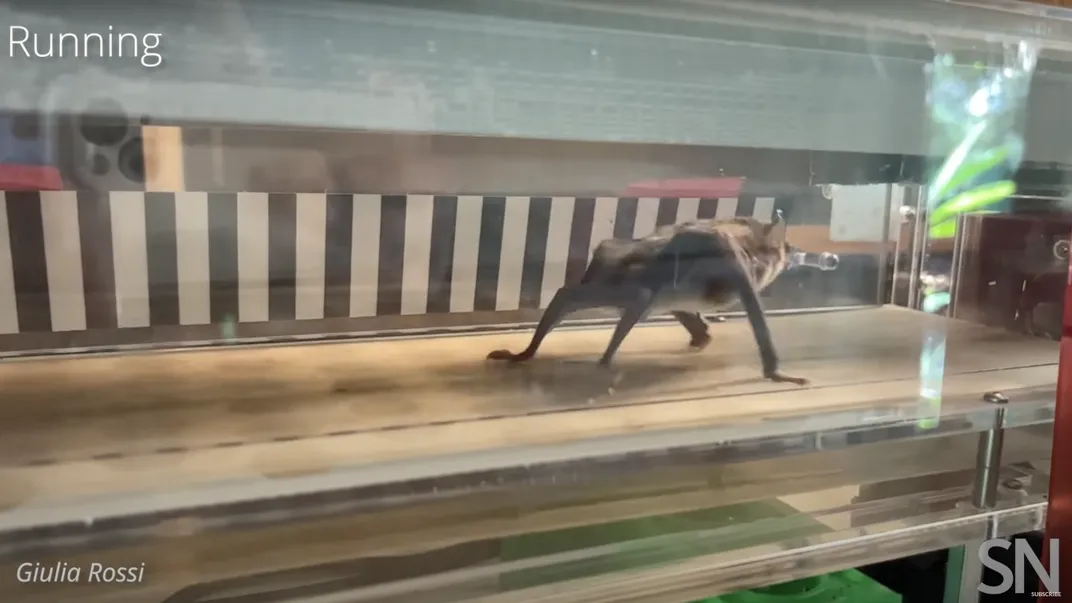Watch Vampire Bats Run on a Tiny Treadmill to Shed Light on Their Blood-Fueled Metabolism
In a rare technique among mammals, the bats burn proteins from blood, rather than carbs or fat, to power their pursuits of prey, according to a new study
:focal(503x326:504x327)/https://tf-cmsv2-smithsonianmag-media.s3.amazonaws.com/filer_public/1c/24/1c249e86-ae07-4650-88a7-b4f9bccaefda/screen_shot_2024-11-06_at_121755.png)
While much of the world sleeps, vampire bats from Mexico, Central and South America emerge into the darkness to feast on blood. They fly, crawl and even run to target cattle and other large mammals or birds as prey. Now, in a bid to understand how the nocturnal carnivores fuel these hunts, scientists put them on a miniature treadmill.
In a new study published in Biology Letters on Wednesday, researchers discovered that vampire bats use amino acids for energy as they run. The mammals rely on these building blocks of proteins from the blood of their prey, instead of gaining fuel from carbs or fats, like other mammals do. Vampire bats have a specialized diet made up of mostly blood, and their metabolism is shaped by that diet, the scientists write in the study.
“What’s different here is that this seems to be what this animal is going to do all year round, every day when it feeds, and that it’s making use of the protein in that blood meal that it ingested just minutes before,” says Kenneth Welch, a biologist at the University of Toronto and co-author of the paper, to New Scientist’s Matthew Sparkes.
“That’s what really separates these animals from most of the rest of us,” Welch adds.
Vampire bats are the only mammals that feed solely on blood, in a practice known as hematophagy. Some animals from other groups—like leeches, lampreys or tsetse flies—also feed on blood, because it is full of nutritious proteins and fats they need to grow and reproduce.
Based on the vampire bat’s diet, Welch and his team hypothesized that the mammals would use the amino acids from blood to fuel their running and flying. To test the hypothesis, the scientists studied 24 bats captured in Belize and fed them cows’ blood. The blood was enriched with specific amino acids, such as glycine and leucine, that were marked with chemical labels to help the scientists track them and analyze how the bats were using energy.
Next, scientists placed the bats on a small treadmill. At first, some of them weren’t very eager to exercise: Bats hooked their thumbs into crevices to avoid running, Welch says to the New York Times’ Jack Tamisiea.
“They’re like you or me,” he tells the outlet. “If they don’t want to run on the treadmill, they’ll cheat and stand on the side.”
New paper out! We show that vampire bats use amino acids from a recent blood meal to fuel RUNNING - a rare mode of locomotion in bats ideal for stalking prey. I’d worry less about your neck and more about your ankles! @WelchLab_UTSC @RSocPublishing https://t.co/4H5dg7TsNK pic.twitter.com/H4bGwzbhs6
— Giulia Rossi (@giuliasrossi) November 6, 2024
Once the vampire bats hopped onto the moving belt, they would trot and run. As they moved, the researchers tracked their oxygen intake and carbon dioxide output. By analyzing the chemicals in their exhaled breath, the team found the bats were using amino acids from the cows’ blood to fuel their runs. The glycine and leucine provided up to 60 percent of the mammals’ energy.
The use of recently consumed amino acids isn’t that rare. Most mammals have some type of biochemical pathways that can break down amino acids to produce energy, Welch tells Science News’ Susan Milius. For hibernating bears or fasting penguins, amino acids can offer a meaningful source of fuel, but even in those cases, the animals “are not using amino acids they ingested in a meal only minutes before,” he adds.
Vampire bats’ ability to use recently ingested proteins in less than ten minutes is “unparalleled in mammals,” says Michael Hiller, a researcher at the LOEWE Center for Translational Biodiversity Genomics in Germany who was not involved in the research, to the New York Times.
There’s a caveat to this type of feeding and fueling, though. Since vampire bats can’t store much energy, like carbs or fat, they are more prone to going hungry. And since the amino acids from blood aren’t readily available all the time, they may face starvation easily. This puts the bats at risk of starvation after only a day without feeding, Welch tells New Scientist.
To prevent this from happening, the animals are willing to help each other out. When one member of the roost is hungry, they will often regurgitate some of their own meal to the other bat. This ensures that they’re all ready for another night of flying—or running—after their prey.
/https://tf-cmsv2-smithsonianmag-media.s3.amazonaws.com/accounts/headshot/headshot_2_thumbnail.png)


/https://tf-cmsv2-smithsonianmag-media.s3.amazonaws.com/accounts/headshot/headshot_2_thumbnail.png)